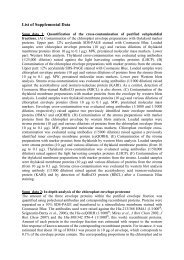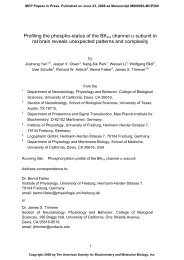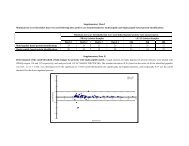Super-SILAC allows Classification of Diffuse Large B-cell ...
Super-SILAC allows Classification of Diffuse Large B-cell ...
Super-SILAC allows Classification of Diffuse Large B-cell ...
You also want an ePaper? Increase the reach of your titles
YUMPU automatically turns print PDFs into web optimized ePapers that Google loves.
(BCL6), immunoglobulin transcription factors 1 and 2 (ITF1 and ITF2), Ets-domain containing PU.1 and<br />
the B-lineage specifying transcription factor PAX-5.<br />
Next we quantified all 30 proteome measurements against each other based on the ratios to the super-<br />
<strong>SILAC</strong> mix and calculated their Pearson correlation coefficients (r). Unsupervised clustering <strong>of</strong> the rows<br />
and columns <strong>of</strong> the matrix <strong>of</strong> the 30 x 30 coefficients co-clustered the triplicates in each case (Figure 2B).<br />
Good reproducibility is further indicated by the high average Pearson coefficients <strong>of</strong> the triplicates (R 2 =<br />
0.87).<br />
Segregation between DLBCL subtypes – To investigate if our proteomics measurements can segregate<br />
ABC from GCB proteomes, and to determine an optimal data analysis strategy, we started by performing<br />
unsupervised hierarchical clustering <strong>of</strong> all proteome measurements. We required that proteins were<br />
present in at least 50% <strong>of</strong> the 30 measurements and filled any missing values by ‘ data imputation’<br />
(EXPERIMENTAL PROCEDURES). Again, replicate measurements were always clustered together.<br />
Intriguingly, the two major branches <strong>of</strong> the dendrogram precisely grouped all the ABC and all the GCB<br />
subtypes together and apart from each other. This indicates that these subtypes have quite different<br />
protein expression patterns at a global level that are capable <strong>of</strong> defining them as distinct entities.<br />
The cluster indicated as B in Figure 3A, consists <strong>of</strong> 107 proteins, 70 <strong>of</strong> which are annotated as<br />
ribosomal, 12 are components <strong>of</strong> the 20S proteasome and 14 are components <strong>of</strong> 26S proteasome<br />
(CORUM annotation) (15). As shown in Figure 3B, their expression varies little across the <strong>cell</strong> lines;<br />
thereby they serve as ‘loading controls’ and validate correct normalization and imputation <strong>of</strong> the<br />
proteome samples by MaxQuant. This ensures that the variation <strong>of</strong> protein expression values between<br />
ABC and GCB can directly be attributed to biological differences between these <strong>cell</strong> types rather than<br />
experimental artifacts. Figure 3C shows the differences in expression <strong>of</strong> two clusters in the upper part<br />
<strong>of</strong> Figure 3A (indicated as C and D) with large differential expression patterns between the two main<br />
[12]








